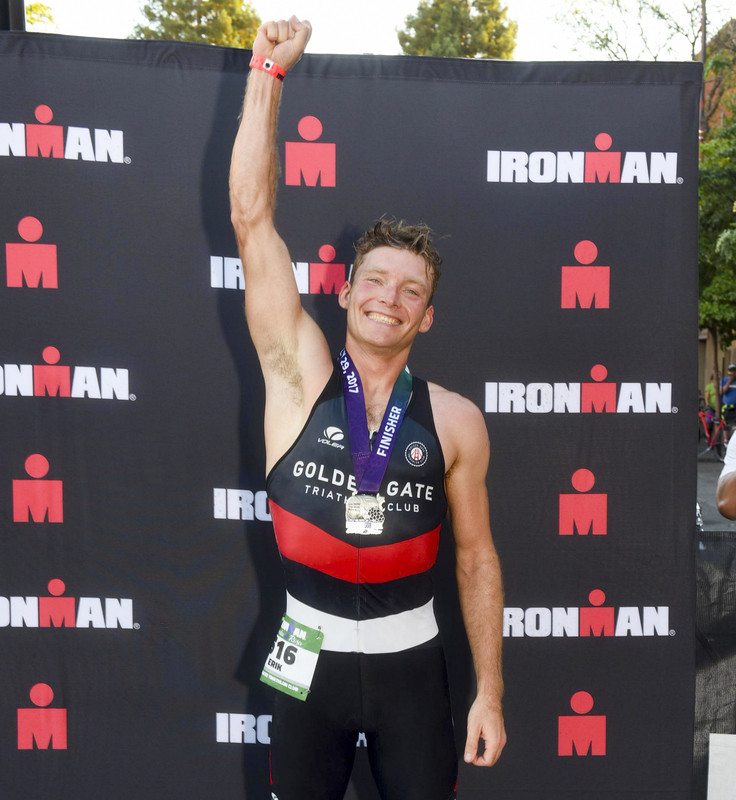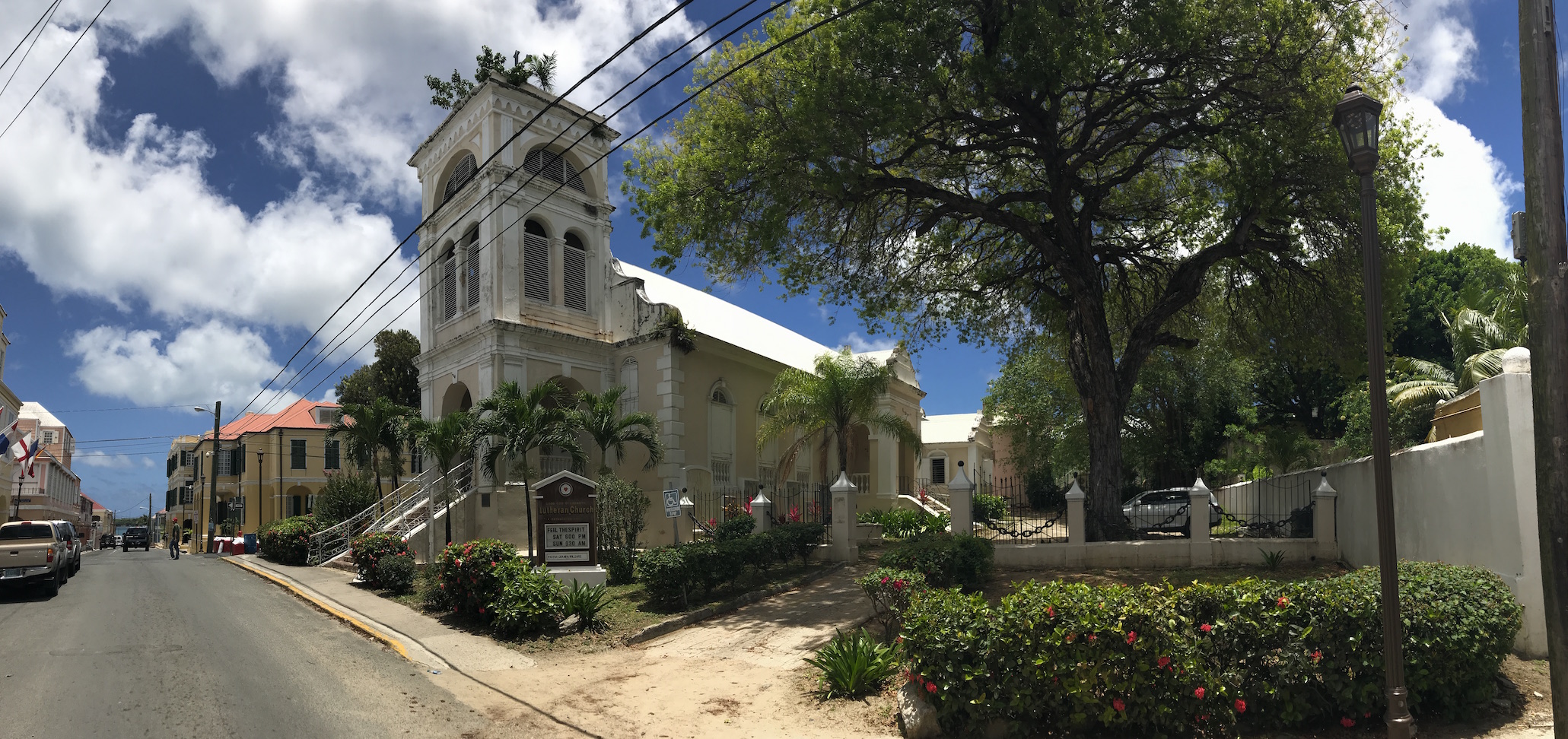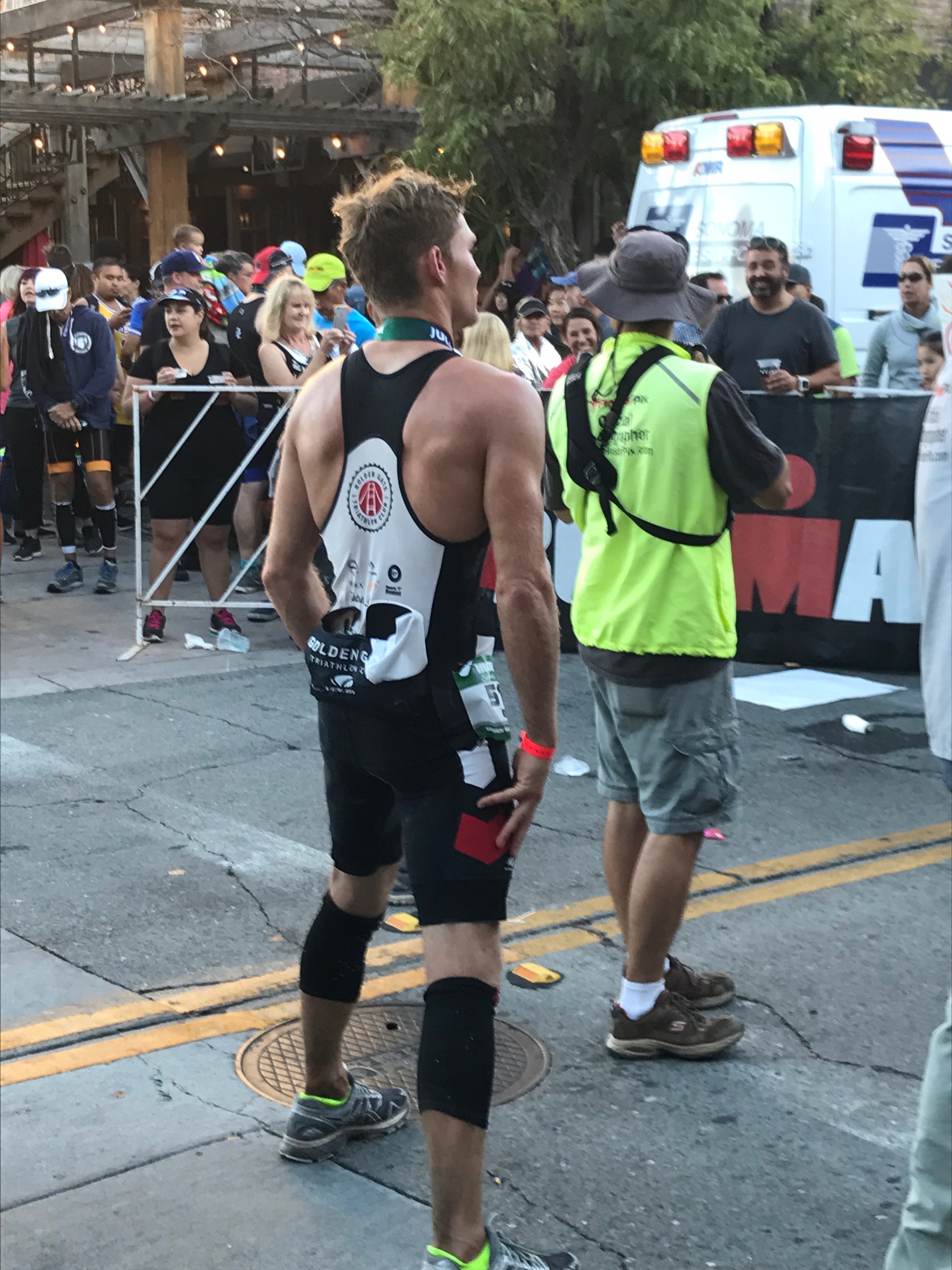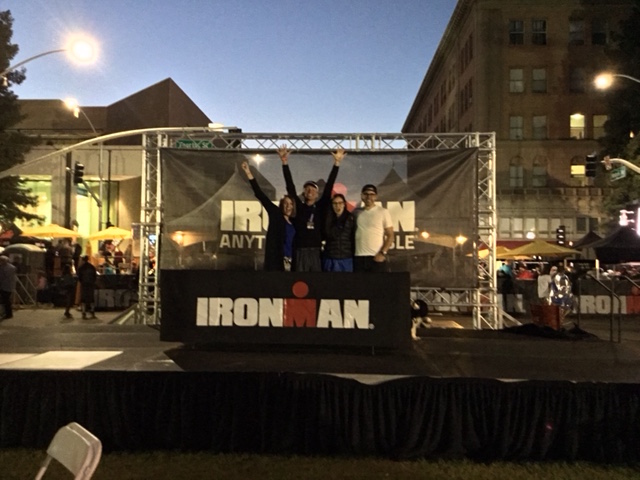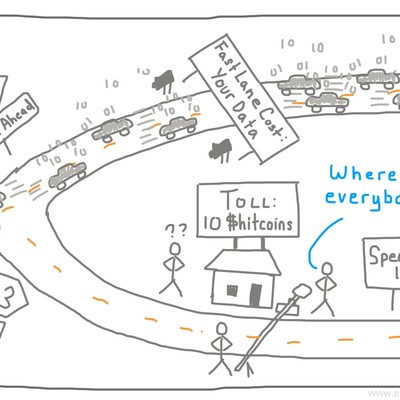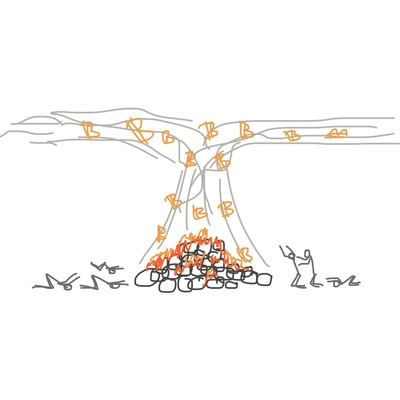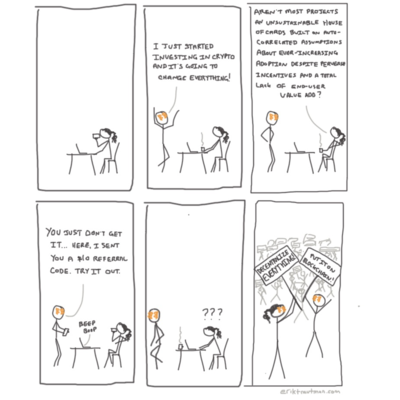I am Ironman.
At 7:41:10pm On July 29th, 2017 I slowed to a halt, put up my hands and wept. I could barely breathe after the deceleration but didn't care because I'd stepped into the moment I'd visualized 10,000 times and it was every bit as sweet as I'd hoped.
This was a moment to culminate the most difficult challenge I've ever undertaken in the course of my life -- and ever hope to. The Ironman triathlon, commonly known as the most challenging single day sporting event in the world, is something so stupidly crazy that it prompts concerned looks and a whole lot of "why?". No one questions any more if you decide to train for a marathon but this mother of all triathlons is that and more -- a 2.4 mile swim followed by a 112 mile bicycle ride followed by a full 26.2 mile marathon.
This 140.6 mile course is the most challenging thing I could possibly imagine a human being voluntarily doing and that's frankly much of its appeal.
In preparation for this moment, I read every blog post I could find and, while they were touching, motivational and educational, none of them really covered the full lifecycle and impact of training for this event. Given this and the number of questions I've received, I wanted to put something together which would really get you inside my head. It's a long one but I haven't held much out -- I included not just race day reports but the full training arc and lessons learned along the way.
Table of Contents
- Why?
- The Road to the Marin Olympic
- Racing the Marin Olympic
- The Road to the St Croix Half Ironman
- Racing the St Croix Half Ironman
- The Road to the Santa Rosa Ironman
- Racing the Santa Rosa Ironman
- Afterward
Why?
I loved wrestling. It was the ultimate challenge, a chance to look your opponent in the eye and take him to the mat with your strategy and cunning as much as your force. It required phenomenal discipline, focus and strength to pull off. Every match was a battle against the terror of confrontation and a ride high on the endorphins of competition.
It also broke me.
When I was a sophomore in high school, during my first wrestle-off for a spot on the varsity team, I shot in on my opponent and felt someone pour ice water down my back. The doctors would take months and lots of images to come up with a few weak theories but later years proved that I had messed up a disc in my back which would take me out for the season and leave me forever prone to reinjury.
When you're injured like that, it has an insidious way of manifesting itself. I'm a competitive person who lives for challenge so of course I want to push myself as hard as I can in everything I do. Unfortunately, I discovered in my late teens and early 20s that the moments when I felt strongest were the same ones when I was most likely to be taken down by a reinjury and condemned to a limping shuffle for weeks thereafter. It messes with a competitive person to have to hold back.
In the later years, I was able to ease into soccer for several months at a time before my back would pull me down. I could lift weights but only up to 90% effort or so before the risk got too high. For me, competitive athletics had been reduced to beer league sports and a consistent but spiritually listless gym regime. After even that proved too much, I admitted to myself that I could probably never really run again.
But you can't keep the lid on the teapot forever. Those of you who know me best are probably less surprised than I was that I ended up crossing that particular finish line on Saturday. It started innocently enough, though.
Last summer, a housemate put out a call to see if anyone wanted to join her in a "sprint" triathlon in October. This is essentially the "entry level" distance, where the swim is 750m, the ride is 20km and the run is a 5k. After initially dismissing the idea, I realized that imagining it had given me that tickle of challenge and fear which I missed.
I also remember watching a telecast years back where they were covering the Ironman world championships in Kona. I recall being amazed at those crazy sun-stretched nutters and their impossible quest. Somehow, that image stuck with me.
So I leaned in and decided that the potential for having another re-injury was a risk worth taking to chase the challenge. When I started thinking seriously about what it might take, it seemed like the sprint might be a bit too easy because I knew I could do those distances based on previous efforts at various points in my life. So I decided to commit to something I didn't know whether I could do or not -- the "Olympic" distance, which effectively doubles the sprint to a 1500m swim, 40k ride and 10k run.
This was far enough to scare me. I'd never run 10k before and didn't know if I could. I remember how hard even doing 500m felt during lifeguard training, so 1500m would definitely be a stretch. But the thrill of not knowing if I could do it was exactly what I needed.
The Road to the Marin Olympic
When I started training, I was amazed at how different it felt to again have a sense of purpose in my workouts. The light at the end of the tunnel, the goal to strive for -- these made all the difference. I felt like Rocky again, a feeling that I'd missed as I drifted through my fitness maintenance over the years after real sports ended.
Then, when I had my first few "brick" days (which combine multiple legs in a single workout), something amazing happened.
Running, after my fraught history with it, intimidates me. I was legitimately scared of how much pain and suffering a simple 10k could potentially cause to my body. I knew that my knees were bad and I worried incessantly that my back would cut out like it had several times before due to running. But, after diving into the freezing cold San Francisco Bay and putting in a lap around the buoys, suddenly I could run again. It was like my body got loosened up in exactly the right ways and it insulated me from the usual pain of running. I won't say that I enjoyed it, but I felt like I could actually run again.
With a new lease on my feet, I started training with more optimism. I wasn't on any sort of official plan as I moved towards October but I made sure to put in the requisite Sunday brick workouts and went in with less trepidation than I started with.
Lessons learned in Training
- Swimming comfortably starts with breath. Don't try to be one of the cool kids who breathe alternately every third stroke... it's okay to always breathe to one side. You feel a lot less like you're drowning and more like you're swimming.
- There is a zen to swimming where you can hit a zone that feels infinite.
- When swimming in the San Francisco Bay, get a damn wetsuit. Any workout >500m turned me blue and made me shiver for a half hour afterward without one, which wasn't only unpleasant but also dangerous on the bike.
- I watched a lot of running videos on YouTube to try and get the form right. Something about being easy and relaxed... still working on it.
- Those little swim racing goggles are not designed for people like me... they feel like someone is trying to remove my eyes with a plunger. So I invested in a larger pair that were sort of halfway to snorkeling goggles. Slower, yes, but a hell of a lot more comfortable.
Racing the Marin Olympic
Despite my uncertainty going in about whether I could complete it, the triathlon itself went as well as one could expect.
The experience was a new one in all ways so just being there with my training partner Chris was a lot of fun. I hit a rhythm early during the swim that I hadn't really found during my workouts, each of which had previously involved some combination of forward movement and preventing drowning. I biked strong (though couldn't nearly keep up with "the fast guys"). Most importantly, I ran 10k for the first time ever and finished strong enough to feel great by the end, clocking in respectably at somewhere around 3 hours.
At the finish line, I actually felt good... really good. So good that I felt like I could almost do it again...
Could have been the caffeine talking.
Goal: Finish.
Actual: 2:51:10
Lessons learned in the Race
- You look pretty odd as the only guy with an iPhone tracking his progress on Strava
- My head is too big for the swim caps they insist on making everyone wear at the event
- Caffeinated shot blocks are like nitro for my body
The Road to the St Croix Half Ironman
Another way to think of the Olympic distance is basically as a "Quarter Ironman". It's a legitimate accomplishment but there's no question that the gold standard is the Iron distance. When I finished that strong in the Olympic, all that sense of purpose, challenge and a touch of body magic gave me a lingering desire to take it further. Throughout November, I stuck with the workouts and ultimately decided to have a go at the next distance up: A "Half Ironman", also known as a "70.3" because of the total distance in miles.
This event combines a 1.2 mile (1900m) swim, a 56-mile (90km) ride and a 13.1 mile half marathon (21.1km).
The big difference here, though, is that a 70.3 is no joke. You can start in pretty good shape and clean up your form and make it through your first Olympic distance triathlon. A Half Ironman is more than 6 hours of activity and each leg is a feat in and of itself. For me, the idea of running a half marathon was easily the most intimidating part of it.
But that challenge was tantalizing...
I was also at a point in my life where I felt extremely boxed in by my lifestyle and work so I really needed an escape. That prompted me to look for an early season race in a location where I could spend a few weeks on a "workcation" (I work remotely) as a reward for hitting a key milestone at the end of March. I settled on the Caribbean island of St Croix because it was gorgeous and well timed in early May. I booked everything in December and then sat back to wonder how the hell I was going to pull it off.
This was going to be The Real Deal so it was time to get some support and to get serious about training. I joined the Golden Gate Triathlon Club (GGTC) in December to lean on their community and expertise. I trawled the internet and combined a series of workouts into a plan that seemed to make sense. It was 6 days per week and ramped up quickly.
A lingering foot injury in December (sustained while dancing, but most likely a result of my $30 bargain sneakers) scared me. I knew my injury history would make it very difficult to ramp up fast enough and I'd never taken on distances like those I was looking at in the spreadsheet. Again, the runs were intimidating. At this point, the most I'd ever run was the 10k during the Olympic tri. Could I really finish it?
I took on physical therapy like it was my job throughout December and got well enough that I was able to officially begin the 16-week St Croix plan in early January.
The Good...
Training was a new sense of purpose but it was also a refuge. Amidst the stress of work, it provided an excuse to block off a couple of hours in the middle of the day. The first time I went running mid-week down Marina Green in the sun was a magical "is this my life?" kind of experience. I joined a pool and absolutely loved that energy I would get after finishing a swim, even if it seemed really challenging during the workout. My time on the exercise bike at the gym turned into a great excuse to read my Kindle while being productive.
Basically, the lifestyle of tri training felt right.
...and The Bad
As training ramped up in earnest, though, I found myself with less and less energy. When I first committed to this, I told myself that, while I was willing to box off the hours required to accomplish the goal at hand, I wouldn't let it own my life.
Unfortunately, I found myself so worn out after the longer workouts that I really didn't have any energy to do a lot of the other things I wanted to do. My Friday and Saturday nights quickly became early nights in and I would spend hours after the weekend workouts shattered on the couch from the exertion. Not that I really admitted this to myself... I was too busy making day-of excuses why I wasn't doing much else.
I flew out to St Croix in mid April and promptly got punched in the face by the conditions there. The first weekend, I had an epic exploratory ride which netted me a sunburn I still wear 4 months later and then a long run which showed me exactly how unprepared I was for the humidity. I promptly got sick and still count that first St Croix long run (12 miles) as one of the worst.
At least the scenery was good...
Every single run I had to do became a sufferfest that I dreaded. My body felt like it was shutting down from the inside out rather than just succumbing to muscle tiredness like I was used to. It's worth noting that I ran with water more often than gatorade and certainly didn't know much of anything about salt replacement. Those lessons came later and would have been rather helpful sooner.
Swimming in the warm ocean, though, and riding along the epic vistas was as invigorating as the running was awful. The change in scenery made training fun when I could plot a new route, though the hills and poor road quality often proved confounding.
As before, though, balancing a normal work load and a still-growing training load left little room for the other pieces of living, an imbalance which was especially sharp in such a beautiful destination.
But it's hard to complain amidst such beauty... Unless you're trying to run, in which case it's simply the absolute worst.
Lessons Learned in Training
- Your feet are everything so invest in good running shoes and a proper fitting.
- Training in humidity is the absolute worst because your cooling system fails completely and you feel like death.
- 85 degrees at 80% humidity requires something like a liter of water per mile on a run, way more than you can carry. And carrying that much water sucks and chafes your neck.
- A singlet will smudge away your sunscreen and leave wicked tan lines.
Racing the St Croix Half Ironman
I got my ass handed to me during the St Croix 70.3. I don't know how else to put it.
I had trained with a goal in mind -- if I could do 3 hours at an Olympic, I should be able to do 6 hours at the half. Well, assuming I finished at all, which was far from assured, but you have to have a goal, right?
I didn't even come close and was lucky just to avoid bonking out.
It started the night before when I ate as much gnocchi, caesar salad and pasta sauce as I could. More food means more energy, right?
No... more food means staying awake on a sugar high, having a full stomach the next morning and 5 trips to the porta john before the race starts. It means feeling low energy. I really should have Googled race nutrition.
Of course, the morning of, I still ate a big breakfast of oatmeal and eggs, despite not being slightly hungry. I knew this race would be a hard one so I wanted all the calories I could get. I also started early with coffee (I'm very sensitive to caffeine).
By the time I got in the water to swim out to our starting point on an island in the bay (which was gorgeous, by the way), I already felt off. We sang the national anthem, fired the cannon and got the show started.
1.2 Mile Swim
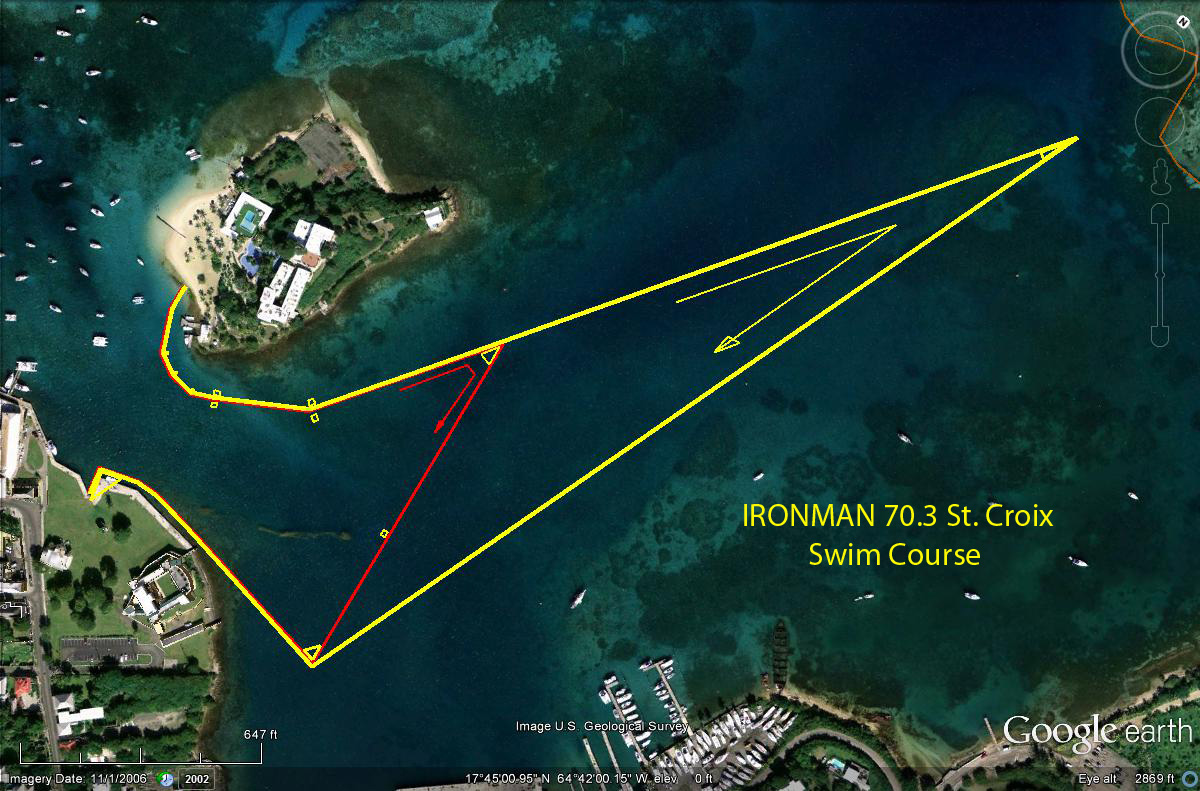
The bay was choppy and I swam with the pack to try and hit my goal time so I ended up expending all sorts of energy fighting for breath in the surf, jockeying for space and riding the caffeine high. It felt way more difficult than training had by the time I exited the water. I was fatigued going into the first transition ("T1").
56 Mile Ride
The ride started with a dusting of rain which meant that many of the race leaders had already wiped out on corners and their bloody road rashes were visible as they passed on the loopbacks.
This race course had a significant elevation gain of 4,519', including a ridiculous 15%+ grade called "The Beast", and at least 20 miles of strong island headwinds. I knew this since I'd trained locally for the past couple of weeks but was determined to work hard for my goal. I calculated that I would need to average at least 16mph to do so and had only managed about 14.5 in training.
Naturally, I ended up spending lots of energy trying futilely to do this. My full stomach (which I kept topping off with solid foods) certainly didn't help the energy management.
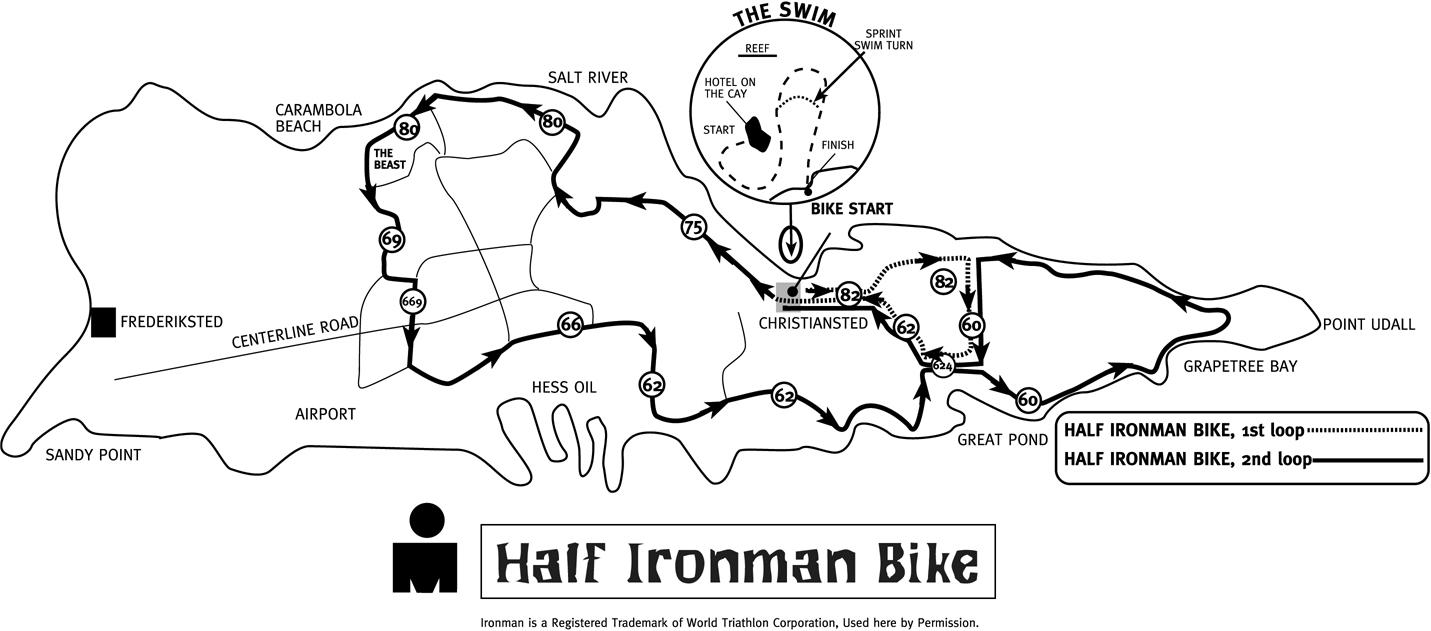
It's also worth noting that the bicycle I was on was a hacked-together cyclocross-meets-road thing where the seat tilted forward at a crazy angle because it had never been fitted and I had constant knee pain on longer rides which drove me to toy with the geometry in weird ways. This was the first non-mountain bike I'd ever had and it has seen some serious years. It was NOT a good race machine.
13.1 Mile Run
By the time I got to the second transition ("T2"), I'd just finished a long sprint down my favorite part of the bike course (finally, a tailwind!) and was determined to survive the half marathon to come.
The run course here was another big elevation gain (~600') in the heat and mostly on unshaded asphalt. I started off with a good caffeine buzz from gels but quickly started suffering in the heat as I had during my training runs.
Add to that bad legs from overexertion during the ride and a terrible nutrition plan that left me feeling full and you have the recipe for disaster.
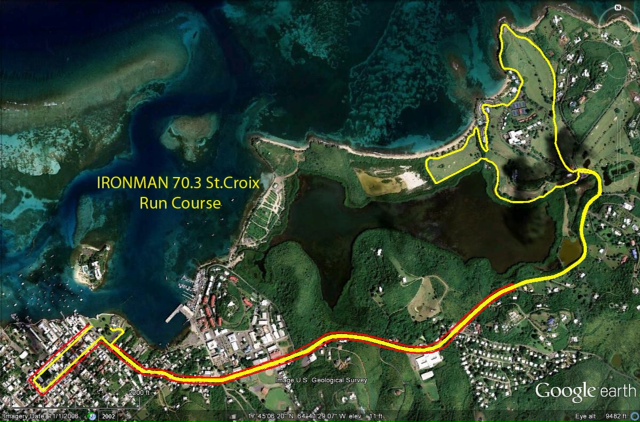
I got destroyed. The first lap (of two) was hard but I did it. The second lap was a cry for help. My body wore down. My knees started falling apart and I ended up leaprogging with a 73 year old who eventually left me behind. I ended up hobbled and humbled, needing to walk/limp three separate times within sight of the finish line.
When I finally crossed, I could barely muster enough vigor to raise my arms and definitely not enough to remove the grimace from my face.
Goal: 6:00:00
Actual: 6:49:33
Lessons Learned at the Race
- The pace you train at is the pace you will race at... don't get weird ideas about going faster.
- Do NOT stuff your face with carbs the night before because you will stay up late and be full
- Get a real road (or tri) bike to race with and GET IT FITTED.
- Having a time goal for a race distance you haven't done before is crazy and trying to stick with it will make you miserable
- Starting the race with low sleep and high caffeine is a recipe for overexerting on the swim
- A half Ironman is way more difficult than I expected
- Unless you're contending, calm down at the aid stations on the run. Throwing gatorade down your throat as fast as possible saves all of 5 seconds and makes you miserable.
- Knee pain is the enemy and I need to focus all my training on beating it. It starts with the bike.
- Over-exerting on the bike is pointless and will kill your run and make you miserable.
- Replace the time goal with being aware of your body and listening to what it needs.
- Course selection is important. If you don't want to run hills, make sure your course doesn't have them.
The Road to the Santa Rosa Ironman
Sometime near the end of the year, I got it in my head that I should do more than just the 70.3. There's something that just doesn't sit right about climbing half of Everest. About putting in all that effort and going halfway. Yeah, 70.3 is a serious accomplishment... but...
I also wanted to take on the biggest challenge I possibly could. The prospect of doing such a difficult race as the 70.3 had unlocked my competitive spirit and it was hungry. I wanted to learn something about myself from a challenge. I wanted to be terrified.
I considered actually trying to climb Everest (yeah, the actual mountain) but decided the reward definitely wasn't worth the risk. But mountains don't always have to be mountains.
There were moments over the years when I was surging while warming up on a rowing machine and I would imagine how it might feel to do something Real like a marathon or... or an Ironman. The Ironman was this phantasm of pure pain and grit. And it had wedged in my brain.
So as I set my goals for 2017, I realized that I one had snuck in which was so crazy I felt like I couldn't even say it out loud.
It took me 4 months to work up the stones to register for the event. I would spend hours looking over races and imagining what they'd be like. Then one day I got fed up and decided to stop treating it like a "well, maybe..." kind of goal. A conditional "I mean, if I don't get injured before then..." cop-out. I picked the close-to-home race in Santa Rosa which ran close on the heels of the St Croix race (less than 12 weeks) so, even if I flamed out, it wouldn't waste my whole summer.
Phew... game on. So I knew going into St Croix that it was just the first peak and that the real mountain lay in the 3 months beyond. I didn't even try to think about it much during training, choosing instead to focus on the present until I lay there recovering amidst the pains of that rough 70.3 and looking at a calendar almost exclusively dominated by workouts and topped by the savage crag of a full Ironman.
Learning from Failure
After the St Croix debacle, I thought hard about how I could learn from it. I was filled with anxiety at the prospect of having to do this on an even longer course. Unlike the post-olympic glow of October, when I felt like I could take on the next level, it was abundantly clear after I could barely finish the half that my body was nowhere near in good enough shape to take on the next level. And I had just 12 weeks to get there. Dang.
A few lessons, though, were encouraging.
First, I completely surrendered any idea of having a time-based goal. I knew that just finishing would be difficult enough and I saw how a time goal had destroyed my race in the Caribbean. More than that, the time-based goal had also been a strong factor in the intensity of my training, which left me feeling irritable and drained most of the time. In a strange way, changing the IM goal from my original (don't laugh) 12 hours to "just finish" took tons of pressure off and allowed me to accept a scaling down of the intensity of the long workouts along the way.
Second, I knew I had to fix the bike situation immediately. It had created the crippling knee pain and slowed me down at every step of the way so the first thing I did upon returning to San Francisco was to pony up for a basic used Specialized Roubaix, a road bike based on comfort. I also got it fitted and switched from mountain-bike cleats to "real" road cleats.
The difference that these changes made was astonishing. If I had to quantify, it was something like 10% immediately gained (which is enormous on the bike) plus I no longer had knee pain midway into my rides.
Third, I knew I had to focus on energy conservation through nutrition and form. I finally realized that endurance racing requires endurance (woah!). Freed from a ridiculous time goal, I could focus my efforts on optimizing for sustainable exertion through good form and well-thought nutrition.
To this end, I improved my training diet incrementally and spent the hours of focus in the pool, on the bike and along the trail thinking about how to relax instead of how to move faster. As importantly, I started researching race nutrition, which surfaced my mistakes around poor electrolyte management in the heat and poor calorie absorption through solid food.
I started my 12-week countdown with a new philosophy but plenty of anxiety over how aggressive the ramp-up in distances would have to be. Whereas my longest swim, ride and run in the 16-week 70.3 plan were 2000m, 60 miles and 14 miles respectively, the 12-week 140.6 plan would have me hitting 4000m, 100 miles and 18 miles respectively in a very short period of time. I was worried about injury. And convinced that finishing the race would be at best a 50/50 proposition.
The Training Life
Another challenge was the lifestyle. Before St Croix, I'd already been forced to acknowledge how training had neatly boxed out every other aspect of my life outside of work. As the training began in earnest during the IM ramp-up, there wasn't a shadow of a doubt.
For 3 months, my life was a cycle of work, train, eat, and sleep. I didn't even pretend to try to have a balance. The load quickly hit 3 hours per day during the week (with Mondays off) and between 6-8 hours per day on the weekend. Running a business and training for the Ironman had me in a vise.
The only saving grace was the slight reduction in intensity of the workouts (my new philosophy of relaxation), which allowed me to trade the soul-crushing fatigue that had floored me previously with simple boredom. Given how much longer the workouts were, it amounted to the same loss of "outside life" but for different reasons.
Unfortunately, I officially crossed the point at which each workout was enjoyable and into the realm of pointless suffering. I realized pretty quickly where my thresholds of "fun" versus "obligation" began -- somewhere around 45 minutes of swimming, 50 miles of riding and 6 miles of running. I even ran out of podcasts to listen to on long rides and found my attention drifting from the Kindle while I made giant pools of sweat on the floor next to the exercise bike at the gym.
There is no question that I was living an unbalanced life while training and not one that I'd want to stick with long term. I frequently thanked myself silently for setting up the race so close to the half because it reduced how much time I'd have to spend in this interminable training cycle. If I hadn't been forced to schedule some break time around a family rafting trip over a holiday weekend, I might have cracked.
In order to have ust a few hours in the afternoon to work on an art project I became involved with, I woke up at 5am many Sunday mornings. I would skip lunch time so I could race down to the pool and get my laps in before bolting back for a meeting. People who saw me at occasional weeknight events would comment on my propensity for eating during the events. I had to -- I literally didn't have any other time and needed to consume a lot of calories.
My days became boxed in by the need to run while there was some daylight and to swim when the pool was available. I could no longer work late if I wanted to, take care of life admin stuff or get ahead on anything. The idea of planning anything on a weekend was completely laughable.
Life was training.
The Taper
The "taper" portion of the training period is probably every athlete's favorite. Training distances actually peak several weeks before the race and then subsequent weeks give your muscles a chance to catch up again by slowly ratcheting things down again (eg from a 100 mile weekend ride to a 90, then 80, then 70).
The reduction of training volume also means that you finally start getting some of your time back. Even just reducing the time on the exercise bike from 120 minutes to 90 felt like a gift. I hungrily ate up all the reclaimed minutes and fantasized about what I would do when the time was again fully my own.
As race week approached, I did a personal status check and my overall fitness left me a bit confused.
Ever since getting the new bike, I felt comfortable on my long rides and completed them with energy to spare (and at speeds that were a good 1-1.5mph faster than before). I also realized how much more consistent my energy felt on long rides if I ignored caffeine completely.
The long swims in the Bay were still tedious but months of rigorously paying attention to my stroke (elbows up!) and focusing on relaxation paid off with me not getting nearly so tired anymore. I could find the zone and slip into it. I wasn't fast (roughly a 2:00/100yd) but didn't care.
The run was still concerning. On the plus side, there were times midway through a long run when I would feel an inkling of "the zone" (for the first time in my life) and would dial into it. After growing concerned about creeping knee pain again, I discovered that taking an ibuprofen before the run would work magic on my ability to finish free of pain.
But I would still find myself at the end of a 14-mile run exhausted and thinking "oh my god, how could I possibly add another 12.2 miles onto this???" The prospect of trying to run a marathon when my longest training day had been 18 miles of pain filled me with anxiety.
Overall, on bike days I figured my chances of finishing were something like 80/20. On run days that felt much more like the original 50/50.
Race Week
During the final week before Saturday's race, things took a turn for the worse. I tried shifting my whole sleep cycle earlier so I wouldn't be tired for the 3:45am wakeup I'd need on race morning. Instead, my body revolted and refused to sleep while there was still sunlight and I ended up wearing myself down and getting more and more exhausted as the week went on.
I had race anxiety early in the week as well... could I finish? What if I didn't? I've worked so damn hard for this and still didn't know if it was enough.
In addition, during my very last reasonably sized run on Tuesday, I felt my tailbone go slightly out of alignment and become inflamed. As a longtime veteran of the Chiropractor, I know how problematic that can be so I immediately started anti-inflammatories and cancelled Wednesday's workout.
As part of the nutrition plan, I had stopped eating fibrous foods in the last couple of days but the carb load kept me anxious and hurt my sleep.
By Friday, I was exhausted and still beset by the lingering tailbone injury. I could barely stay awake in the car while dropping off all the transition supplies and felt like this might be a deja-vu repeat of St Croix.
I did the only thing I could -- I put on the Harry Potter movie at 4:30pm, crawled into my hotel bed and tried to sleep. It was a weird night but I eventually succeeded.
Lessons Learned in Training
- Caffeine management means reducing it until the last possible moment
- Good form on the swim means reducing your pulse as much as possible
- Good form on the bike means reducing your pulse as much as possible
- Good form on the run means reducing your pulse as much as possible
- ...so basically, the ideal form is the one which allows you to relax as much as possible.
- Taking an ibuprofen before a run is a magical tool. Adding a dash of caffeine even makes it almost enjoyable.
- The best anti-fog for goggles is a single drop of a solution of baby shampoo and water smeared lightly over the lens. Foggy goggles are the easiest way to destroy my rhythm.
Racing the Santa Rosa Ironman
When my alarm went off at 3:45am on Saturday morning, I knew I was as ready as I could be. All the exhaustion, anxiety and uncertainty had somehow -- blessedly -- burned off in the night. I felt connected to my body and centered in my head. I had just a single sip of coffee, ate my "light" breakfast (strawberries, banana, oatmeal with raisins and 2 eggs) and headed down to the race.
Despite a long shuttle ride to T1 in the dark, I felt calm but not tired.
2.4 Mile Swim
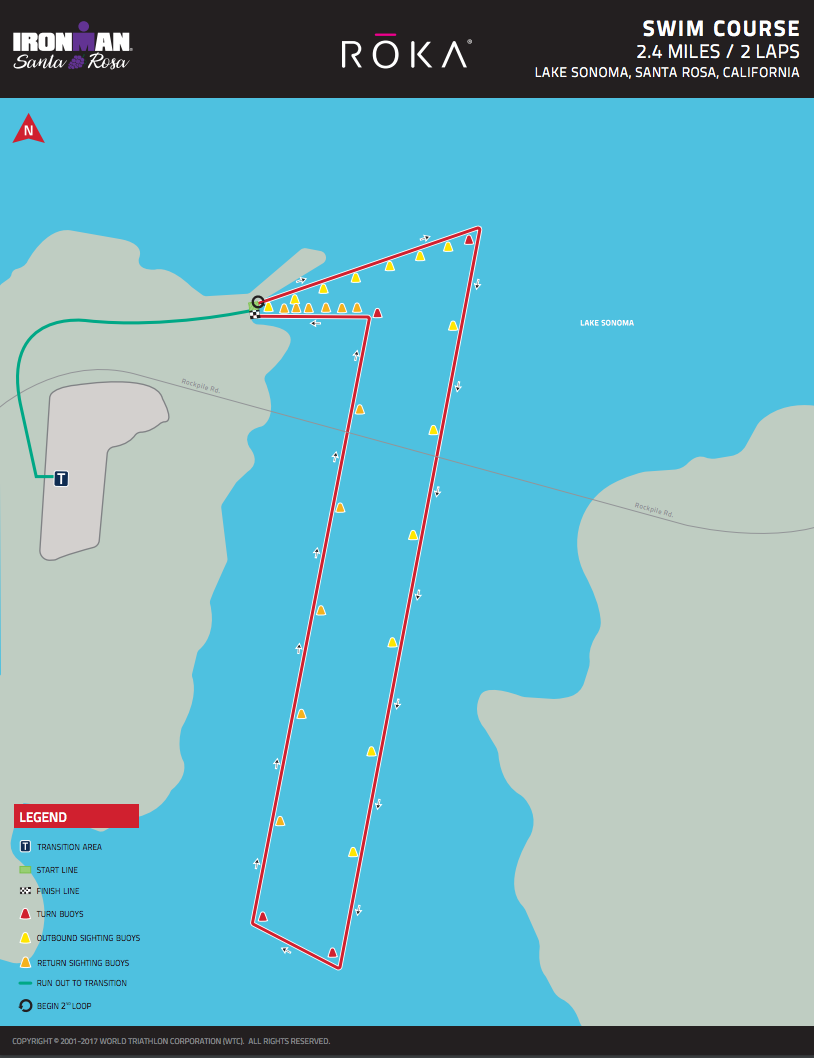
The start moved pretty quickly and, mashed amidst 1700 other wetsuits (they'd announced that morning that it was just cool enough to wear them), I hit the water of Lake Sonoma at 6:24am.
Learning from my mistakes in St Croix, I immediately went wide and found some calm water. The warmth was blissful and I quickly found my stroke. I focused on staying relaxed and enjoying the experience. The dawn lit up the bridge and set the bubbles off my hands afire as they entered the water.
When I got back in the herd near corners, I shrugged off the feeling of people bumping into me and focused on the novelty of seeing their feet materialize ahead as I moved past.
The second lap started with a brief step onto the ramp and then back into the water. Things had warmed up enough that I had to open the neck of the wetsuit periodically to let the cool water in but that felt heavenly. I maintained my zone and finished feeling like I could swim the Amazon.
Because water levels were so low, the brisk walk up the boat ramp probably had as much vertical elevation as the whole marathon. I was amused by the the people who opted to have their wetsuits removed halfway by flopping onto the ground and allowing someone to yank them off by their feet.
In the changing tent, I ate the second half of my oatmeal, raisin and egg breakfast and took the time to stretch. I wasn't in any hurry and certainly wasn't as high strung as some of the people who devolved into screaming fits at perceived slights in their right of way to exit transition with their bicycles.
112 Mile Ride
The bicycle course was nominally easier than any long ride I'd taken in several months. It was longer -- at 112 miles -- than these rides but the elevation gain of just 3,166' (with a net loss of 424') was far short of my usual Sunday climbs of 5-7,000' in the hills around San Francisco. I knew I could finish this and focused on setting a pace that felt comfortable but not expensive.
The hardest part was to fight the instinct to chase people when they passed me on their fancy tri bikes and focus on keeping my own pace. Every time I felt my pulse rising and found myself working to pass, I backed off the throttle and settled down to about 120bpm.
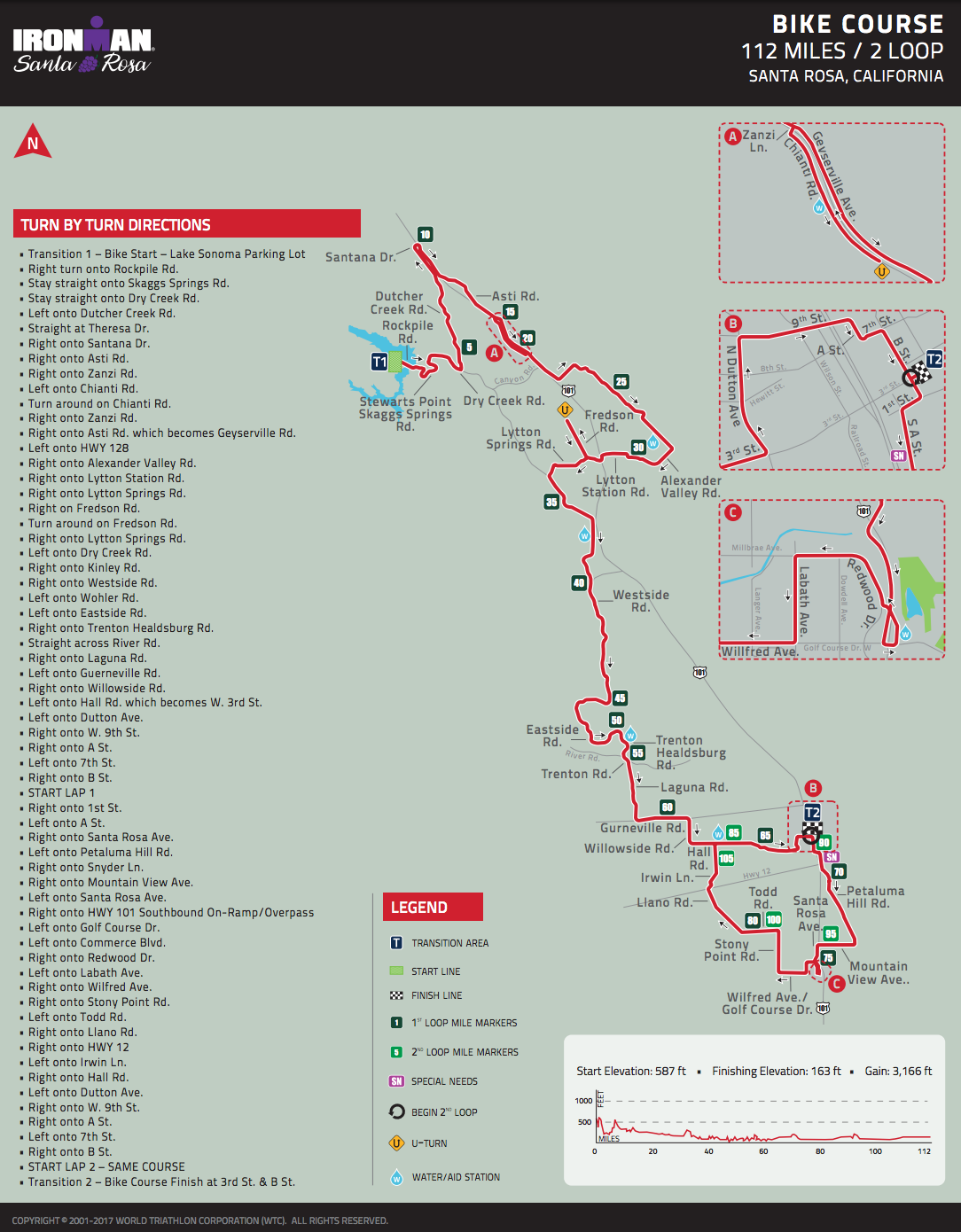
The key portion of my race day nutrition plan was on the bike. I'd learned what not to do in St Croix and spent a fair bit of time on the web in the week before Santa Rosa learning about caloric absorption rates (200-300 Cal/hr on the bike) and how important it is to replenish them in anticipation of depleting your previously stored glycogen during a race of this length.
To take care of this, I committed to drinking at least full 32oz Gatorade (240 Cal) between every rest stop (~45 mins) and alternating every hour eating a banana and a Clif bar. I ignored water completely and only drank gatorade to make sure I was getting as many liquid calories as possible.
One thing I definitely did right was to keep drinking even though it meant stopping later. The race started out in the cool of the morning so I ended up having to step off the bike and pee several times to remove the water but figured it was a price well worth paying against the threat of dehydration later. When the day warmed up around the halfway part of the ride, things balanced out and my sweat loss kept me at a good equilibrium.
At mile 68 we got our "special needs bag", a disposable satchel into which you can put anything you want during the race. I picked up a bagel with smoked salmon and a previously-frozen coconut water (wrapped in foil) which was a welcome break from sports drinks without sacrificing too many calories. If I was moving at a highly exerted race pace, I probably wouldn't have been able to take down that sandwich but it was heaven to focus on how good it tasted when my seat was starting to become particularly uncomfortable.
Another conscious decision I made was to forgo fancy race computers and trackers in favor of a simple watch. When I have dynamic metrics in front of me, I tend to fixate on them and optimize for them to the detriment of my energy management. In this case, not being able to know where I was except to the nearest 10-mile marker allowed me to enjoy the rolling vineyards and the pleasant feel of the sun along the way. Plus, it gave me an excuse to do lots of mental math for speed calculation during the less interesting bits.
The last ~40 miles took place in a 2-loop course which wasn't in the best of conditions -- variable road quality and headwinds -- but I was too busy thinking about the run to pay it much mind.
When I hit the 100 mile marker, I got a boost of self confidence because the longest ride I had ever done was 102. At this point of the race, my saddle hurt mightily but my legs felt strong. I felt the same kind of sustained "pump" I was used to when lifting at the gym but instead my legs were like machines running on an endless supply of Gatorade. In a strange way, the saddle soreness was a boon because I began to fantasize about how good it would feel to start running instead. THAT had never happened before.
With just 15 minutes until transition, I popped a 200mg ibuprofen and had my first caffeinated gel (about 8mg), part of my plan to fight pain and build energy going into the run. I still didn't know how fast I was going but was pretty astonished when I hit transition before 3pm, which was the earliest boundary I'd expected. I was lifted immediately by seeing a group of friends cheering as I stepped off the bike and made my way into the final transition tent.
At this point, my energy conservation and nutrition had done their job -- I felt strong and figured at the very least that I had a good half marathon in the legs. After that, who knows? I stretched with my friends on the other side of the barrier and hustled out of T2 ready for action.
26.2 Mile Run
One of the quickest things I noticed was how different my stride felt with nothing in my hands. I was used to running with at least a water bottle and my big iPhone in my fists. Knowing that I didn't need to track my distance and could get hydration at the rest stops every mile or so meant I had my hands completely free. Somehow that made all the difference -- I was able to chop my arms and use the extra energy in my upper body to augment my stride in a way which made it much more sustainable.
The run course was everything you could hope for in a marathon course -- three ~8-mile loops down a creek with rest stations every mile or two and a total elevation gain of only 277' (less than St Croix in twice the distance). Half of it was on packed dirt (better for the knees) and most of it was under shade so overheating wouldn't be an issue.
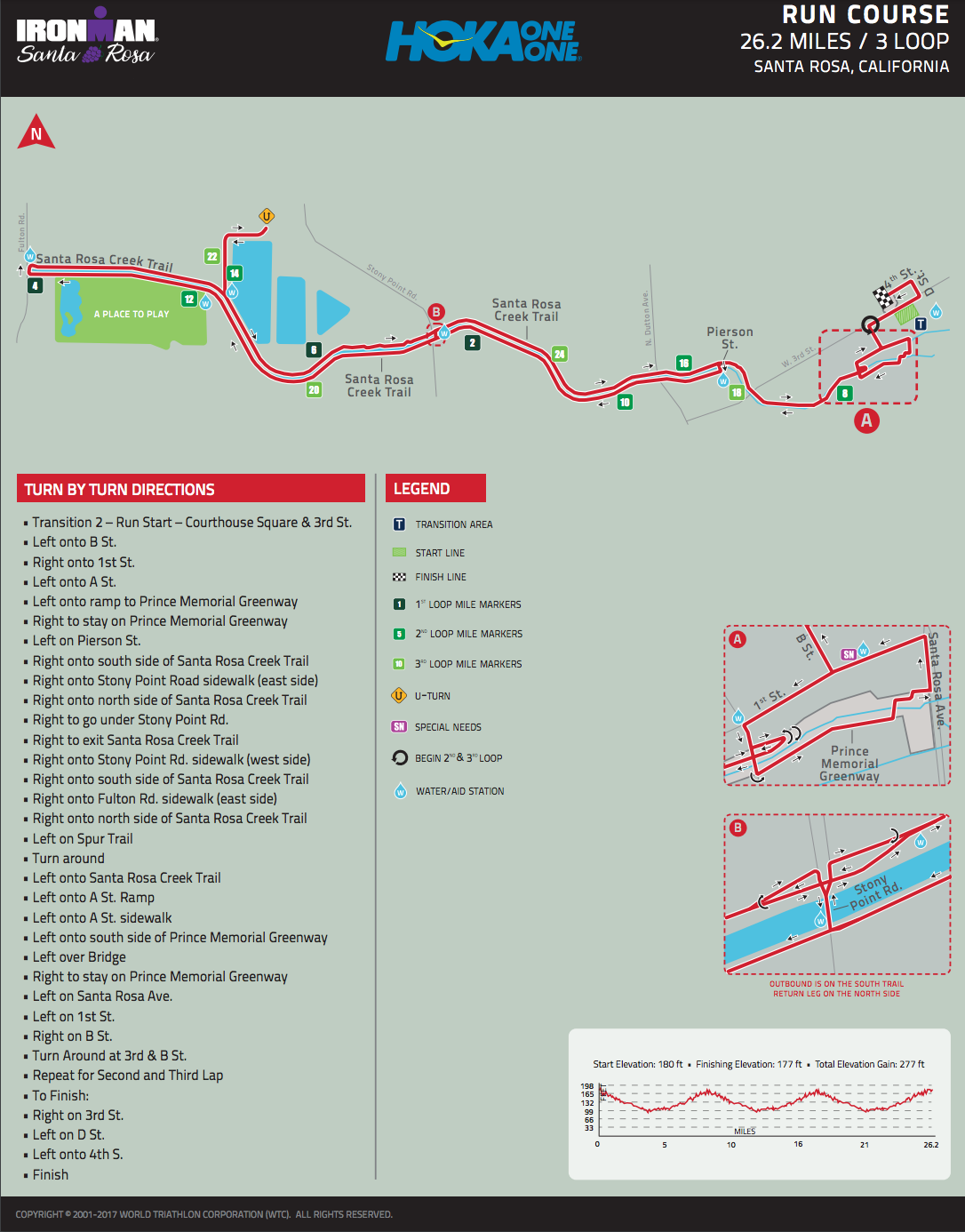
My mission on the run was to make it to the final lap. I knew that I could make it through the first lap and I knew that I would crawl with two bloody stumps for the final lap if I had to in order to finish. The tricky one would be the second lap, when I hit all the distances which had hurt me so much on my long training runs.
My nutrition plan for the run started with a plan to walk through every aid station (it's silly to spill it all over yourself by running through) and get a cup of Gatorade. When I didn't have to pee as much as I thought I should, I added a cup of water to the mix as well but otherwise stuck to the formula.
The first lap came and went. The course was a novelty the first time through and it was fun to be a part of such an endless pack of other runners.
The second lap began and I took my second caffeinated gel and ibuprofen, knowing that the pain would otherwise lurk around mile 10. This time, I found a few other runners from my club to pace with for awhile and was thrilled to see the mile markers ticking up to 10, then 12, then 14. I started getting excited at that point because I could feel that my body was in the zone. The pain hadn't kicked in. I knew my achilles tendons were stressed and my IT bands were a bit confused but my arm-swinging stride kept me going like a machine and the final lap kept getting closer and closer.
Mile 16 came and went. I'd only done this twice on my runs and both were sufferfests. This time, I actually felt good.
Just before the final lap kicked off, I dug into my special needs run bag for a chana masala burrito and took some really satisfying bites. This was to combat a feeling I'd gotten on previous runs where my stomach went sour from a pure-liquid diet and it tasted heavenly. Certainly not the ideal running food but I'd tested it before and I knew it wouldn't be a problem.
When the final lap started, I was filled with emotion. This was it, this was my race. Nothing short of decapitation was going to stop me from crossing the finish line and I knew it. Even more, I still had my stride. Every other long run had devolved into some form of shuffling towards the end but in this one I was still planting, swinging and striding well. My energy was up.
When I passed the 18-mile marker, the longest distance I'd ever gone in training, I choked up a bit and probably confused some of the nearby runners. I couldn't believe that my body was going to make it.
Around mile 20 I realized that no one had passed me in a long time. The course was full of people walking or shuffling forward but all the fast runners had obviously already finished. Every time I passed someone, I got a boost. Every time a spectator shouted how strong I looked or how good my stride was, I pushed just a little harder. The trickiest thing became leashing the power so I wouldn't bonk out or injure myself.
As I rounded the mile 24 marker, it became harder and harder to keep it together. Feelings of immense gratitude and appreciation were rolling over me. To avoid cracking up, I moved faster. The zone merged with the emotion and I found myself in a state of euphoria I'd never experienced before. I picked up the pace and passed more people.
Spectators became a blur and my vision narrowed. I was a freight train and a fighter jet, surging forward with raw unstoppable power. I was sky high, at once soaring next to myself and circulating through my own veins with every beating of my heart. A little voice told me to be careful not to blow out my ankles but the mile 25 marker came and nothing could stop me from taking the leash off. I hit whatever you call it when a marathon runner attempts to sprint.
The last mile was the longest I've ever run but also the most epic. The euphoria and emotion kept building as I got faster and faster, leaping around the walkers and astonishing spectators with my pace. I cared about nothing so much as I did crossing that line.
In this state, moving as fast as I possibly could, I entered the final chute and zipped past another dozen athletes before getting the final 40 yards, 30, 20, 10. The spectators were pounding on the side walls, creating a thunderous roar which I heard swell as I came through.
At the very edge of my capacity, tripping on the endorphins and choked up with a hundred emotions, I crossed the finish line and suddenly had nowhere else to run. Then I heard the words I'd imagined in my head for almost a year, like the sweetest syrup to my ears: "Erik Trautman, you... are... an IRONMAN" and I broke down into sobs mixed with asthmatic wheezing as I gazed around in a stupor and realized that I had arrived. At long last, here it was. I was indeed an Ironman.
There were tears all around, hugs, photos and mylar blankets. I didn't collapse or break down seconds later because I hadn't earned this by shattering my body in a single day. I'd earned it by sweating through hundreds of workouts over many months. By waking up at 5am to plunge into the freezing bay. By tackling a dozen mountains on the bike. By suffering through the long runs and the short runs. And by executing a race plan which let me enjoy the experience from start to finish.
So I didn't shut down, instead I basked in the ever so rare feeling of accomplishing a goal of such awe-inspiring magnitude that it seemed terrifyingly impossible not so long ago.
Goal: Finish. Estimate: 14-16 hours.
Actual: 13:16:50
Lessons Learned in the Race:
- Race day nutrition is king.
- All liquid should be gatorade and as many calories as possible be liquid. Don't bother with water until the run.
- Add some solids (bananas, clif bars) on the bike but only by hour.
- It's far better to pee at the side of the road several times than finish dehydrated.
- Runner's High is real
- Your muscles can do insane things if they are properly fueled
- The race itself can actually be enjoyable! Seriously, I never once considered finishing with a smile.
Afterward
As I write this, I'm still amazed that I pulled it off and enormously proud of doing so. I'm incredibly grateful that my body held up amidst so much abuse and such a steep ramp. I'm humbled by having my friends join me to share the moment. The feelings persist long after the soreness fades.
With such a peak experience, I can see how easy it is to become addicted to the feeling. I understand why people keep coming back.
I also know that I never will.
This race was literally the best possible race I could have run. If I had a team of Soviet scientists next to me the whole time, I'm not sure I could have done better and there were certainly a thousand paths to failure -- a muscle strain here, a disc inflammation there, indigestion and heat exhaustion. I managed to beat my best expected time (14 hours) by almost 45 minutes just by running "my race". I experienced a high unlike any other in my life and finished as strong as it's possible to finish -- not being passed by a single person for over 8 miles and sprinting to the finish. That's a feeling that is impossible to replicate.
And the cost of doing so is extraordinarily high. I sacrificed a lot to reach this pinnacle.
In all of 2017, I don't recall a single Friday or Saturday night out. I certainly haven't forgotten what it feels like to be so exhausted you can barely lift your head. I haven't forgotten all the events I missed due to an early bedtime, all the friends I didn't see because I had a date with the sunrise the next morning. Nor have I forgotten how little I enjoy the boredom of a long swim, the saddle soreness of a long ride and the aches of a long run.
For some people, this routine is their life. They wake up each day living to train and they surround themselves with people possessing the same inclinations. I met many of them during this arc of my life and, as apparent as it is that they love the daily grind of this sport, I clearly don't share enough of that passion to construct my own world around it.
There are a thousand things I want to do with my time and my energy which have nothing to do with running, swimming or riding for 3 hours on a weeknight. This has been an extraordinary opportunity to forge my will and my body into something that is truly iron but it is a pursuit that I'm happy to leave behind as I shift my focus to the next quest, large or small, and all of its fascinating and unique challenges.
I suspect that when the soreness truly fades, I'll find myself lacing up the shoes to see how it feels to get back on the trail. I'll certainly put my two wheels to use for occasional rides to explore new mountains and maybe even find my way back to the Bay to catch that invigoration that a mid-length swim always seems to grant.
But for now, I'm well satisfied that this has been an epic, challenging and wholly worthwhile journey which led to a moment that will ever and always remain a high point of my life.

